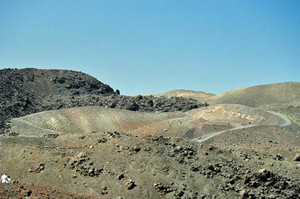Scientists have determined that a 1925 volcanic eruption on Santorini island in Greece was preceded by an influx of hot magma into the volcano's lava chamber several weeks beforehand.
The insight may lead to better warnings of similar eruptions in the future, researchers say.

|
| ©Photograph courtesy Science/AAAS
|
| Scientists studying lavas taken from the crater seen above on the Greek island of Santorini may have found a way to better predict volcanic eruptions in general, according to an August 2008 study.
|
Scientists chemically analyzed rocks ejected by the volcano - a type of "magma forensics" - to determine what happened inside the volcano prior to its eruption, study author Daniel Morgan, a geologist at the University of Leeds in England, said via email.
The investigation started with a discovery by study co-author Victoria Martin of the University of Durham, England, that rounded rocks called nodules released by the volcano appeared to have solidified from an unusually hot magma.
The intrusion of this hot magma into the volcano's magma chamber deep beneath the island's surface probably caused the eruption, scientists concluded.
Carefully analyzing mineral crystals found in the nodules enabled the team to estimate how long the magma spent in the volcano's magma chamber, the underground reservoir that feeds an eruption.
Morgan noted that magnesium-rich crystals found in the nodules acquire iron-rich edges in the relatively cooler environment of the volcano's magma chamber. Over time, the iron and magnesium mixed, blurring the boundary between the inner crystal and its edge.
"By observing the extent of this 'blurring,' and modeling how that happens, we can work out how long the crystal sits in the magma chamber," Morgan said.
The team's conclusion: three to ten weeks.
Future WarningsSimilar studies could even be done with volcanoes that haven't erupted in recorded history.
"This builds up our picture of the volcanic system and helps work out what [a volcano] has done in the past, as a guide to how it may behave in the future," Morgan said.
Bernard Chouet, a seismologist with the U.S. Geological Survey in Menlo Park, California, cautioned that it might be difficult to make predictions with this information.
"Seismic detection would depend on the depth, timescale, and size of an intruding batch of magma," he said by email.
"If the volume is small, the chamber deep, and the time scale of intrusion slow, the intrusion would be hard to detect."
Morgan, the study author, noted: "The more data, the better."
The study appears in the current issue of the journal
Science.

Reader Comments
to our Newsletter